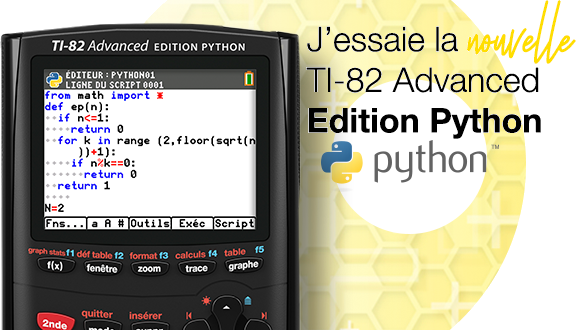Choisir sa calculatrice :
Tableau de comparaison (QCC 2024)
Analyse/Guide complet (QCC 2024)
Tutos mode examen :
Candidats : Activation • Liste modèles conformes
Surveillants : Lancement épreuves • Revalidation
Welcome to TI-Planet, the reference scientific and graphing calculators community !
Grand Concours 2024-2025 - Programmation Python !
-
Facebook Instagram X/Twitter YouTube Discord
Social TI-Planet
-
Donations / Premium
For more contests, prizes, reviews, helping us pay the server and domains...
Donate
Discover the the advantages of a donor account !
JoinRejoignez the donors and/or premium!les donateurs et/ou premium !
Donate
Discover the the advantages of a donor account !
JoinRejoignez the donors and/or premium!les donateurs et/ou premium !
-
Stats.
782 utilisateurs:
>759 invités
>15 membres
>8 robots
>759 invités
>15 membres
>8 robots
Record simultané (sur 6 mois):
6892 utilisateurs (le 07/06/2017)
6892 utilisateurs (le 07/06/2017)
News
- Catégories
- TI-Nspire
- TI-82 / 83 / 84
- TI-89 / 92 / Voyage 200
- TI Scientifiques
- Casio
- NumWorks
- HP
- Symbolibre, Librecalc
- Lexibook, Truly
- Zero
- Examens - Concours
- Divers
- All news
- Latest news
- Ajout simulateur en ligne Casio fx-CG100 à ClassPad.net107
[Casio] (05/03 00:10) - Découvre les nouveaux packagings (boîtes cartons) TI 2025 !265
[Divers] (28/02 11:13) - 2 nouveaux coloris TI-84 Plus CE Python rentrée 2025677
[TI-73/76/82/83/84/85/86] (22/02 10:24) - Luz Rello, nouvelle Women Do Science 2025 par Casio Espagne387
[Casio] (18/02 15:53) - Disparition de Romain Liévin, pilier de la communauté TI819
[Divers] (16/02 19:29) - TI ExamCalc complété avec les TI-Nspire CX II502
[TI-Nspire] (12/02 22:56) - 4 nouvelles Women Do Science 2025 sur coques Casio !445
[Casio] (12/02 21:16) - SDL Tetris, 1ère appli adaptée pour Graph Math+/fx-CG100589
[Casio] (09/02 21:39) - MPM bêta, lanceur application .g3a pour Graph Math+ fx-CG1001501
[Casio] (09/02 17:42) - Extension Women Do Science avec Hypatie sur Graph Math+554
[Casio] (06/02 12:11)
Programs &
Downloads
- Downloads
- TI-Nspire
- TI-83 Premium CE / 84+CE / 82APy
- TI-82 Advanced / 84+T
- TI-82+ / 83+ / 84+
- TI-76.fr / 82 Stats / 83
- TI-89 / 92 / Voyage 200
- NumWorks
- Casio Graph 25 35 75 85 95
fx-7400/9750/9860 G/GII/GIII - Graph Math+/90+E - fx-CG10/20/50
- Casio fx-CP400/CG500
- HP Prime
- 39gII
- 49/50
- 48
- Selections (Exams, tools, lessons...)
- Upload a file
- My uploaded files
- Latest files
-
Explore, Escape
5
[Jeux NumWorks] (ROBERT Vincent) -
calcRADIO!
4
[Utilitaires Casio Graph Math+/90+E/fx-CG] (jjr) -
Thermo Exam 1
6
[Cours et Formulaires Autres...] (ab) -
2017
5
[Cours et Formulaires TI-Nspire] (snail) -
2019
3
[Cours et Formulaires Autres...] (snail) - Latest updates
-
First Fantasy: Mana Force v6.0.1
1731
[Jeux TI-83 Premium CE / 84+CE / 82APy] (DJ Omnimaga) -
Plateforme
16
[Jeux NumWorks] (dkfe123) -
Flappy Bird
164
[Jeux NumWorks] (Aubinouchouchou) -
Space Invader
1092
[Jeux NumWorks] (Gugus_BSS)
- Popular files
-
Oiram CE (mario-like)
551
[Jeux TI-83 Premium CE / 84+CE / 82APy] (MateoConLechuga) -
Geometry Dash CE
523
[Jeux TI-83 Premium CE / 84+CE / 82APy] (Epharius) -
Flappy bird color
497
[Jeux Casio Graph Math+/90+E/fx-CG] (Lancelot) -
CGDoom fx-CG50 / Graph 90+E
457
[Jeux Casio Graph Math+/90+E/fx-CG] (Lephenixnoir) -
Doom (Shareware)
399
[Jeux Doom Casio Graph Math+/90+E/fx-CG] (Id Software) -
PacMan CE
398
[Jeux TI-83 Premium CE / 84+CE / 82APy] (MateoConLechuga) -
Mario Kart CE
375
[Jeux TI-83 Premium CE / 84+CE / 82APy] (tr1p1ea) -
FlappyBird
319
[Jeux TI-83 Premium CE / 84+CE / 82APy] (Rico) -
Snake
236
[Jeux NumWorks] (Golem64) -
Text Editor CE
205
[Utilitaires TI-83 Premium CE / 84+CE / 82APy] (MateoConLechuga)
Converters
- Latest converted documents
- Propiedades mecanicas de los materiales
[mViewer GX Creator Lua TI-Nspire] (Semor) - DIGITALES
[mViewer GX Creator Lua TI-Nspire] (julian rodriguez) - COMUNICAIONES_BRIYIT
[mViewer GX Creator Lua TI-Nspire] (pepeporrassss) - Apuntes_1
[mViewer GX Creator Prog HP-Prime] (smorag) - turbo enonce
[mViewer GX Creator Lua TI-Nspire] (halilk2631) - Propiedades mecanicas de los materiales
[mViewer GX Creator Lua TI-Nspire] (Semor) - samuelosqui
[mViewer GX Creator Lua TI-Nspire] (devydrter) - turbo Ed6
[mViewer GX Creator Lua TI-Nspire] (halilk2631) - turbo Ed5
[mViewer GX Creator Lua TI-Nspire] (halilk2631) - turbo Ed4
[mViewer GX Creator Lua TI-Nspire] (halilk2631)
Forum
- Catégories
- TI-Nspire
- TI-82 / 83 / 84
- TI-89 / 92 / Voyage 200
- TI Scientifiques
- Casio
- NumWorks
- HP
- Divers
- Quick links
- All forums
- Topics of the last 7 days
- Unanswered messages
- Unread messages
- Messages since last visit
- Latest posts
- Re: Lancement bêta-test Epsilon 24 avec nouveau moteur de ca1915
cent20 (06/03/2025 20:01) - Re: KhiCAS en mode examen sur TI-Nspire CX II8665
parisse (06/03/2025 18:22) - Ajout simulateur en ligne Casio fx-CG100 à ClassPad.net107
critor (05/03/2025 00:10) - Re: Appli graphique de RPN (en Python !)2717
XanderLeaDaren (04/03/2025 17:04) - Re: Image et Canal Alpha282
Adriweb (04/03/2025 12:26) - Re: 2 nouveaux coloris TI-84 Plus CE Python rentrée 2025677
ggauny@live.fr (04/03/2025 11:46) - Re: Coloration syntaxique HP Prime417
komame (04/03/2025 03:51) - Re: Python sur HP Prime5933
komame (04/03/2025 03:19) - Re: Donner des ailes à keydown() sur python nspire324
Adriweb (03/03/2025 21:32) - Re: Découvre les nouveaux packagings (boîtes cartons) TI 202265
cent20 (02/03/2025 16:42)
Gallery
- Latest picture
-
TI-Nspire CX II CAS new-packaging-2025
[Nouveautés]
© 2011-2025 TI-Planet.
Website managed by UPECS non-profit organization. See our privacy policy.
The proper functioning of TI-Planet relies on cookies. You can configure (and consent to) the usage of optional cookies.
SmartNav : Off (ON = connexion nécessaireON = login required)
Nous ne pouvons pas forcément surveiller l'intégralité du contenu publié par nos membres - n'hésitez pas à nous contacter si besoinWe may not be able to review all the content published by our members - do not hesitate to contact us if needed (info[at]tiplanet[.]org).
Forum powered by phpBB © phpBB Group — Traduction phpBB par phpBB-fr — Some icons from FatCow
The proper functioning of TI-Planet relies on cookies. You can configure (and consent to) the usage of optional cookies.
SmartNav : Off (ON = connexion nécessaireON = login required)
Nous ne pouvons pas forcément surveiller l'intégralité du contenu publié par nos membres - n'hésitez pas à nous contacter si besoinWe may not be able to review all the content published by our members - do not hesitate to contact us if needed (info[at]tiplanet[.]org).
Forum powered by phpBB © phpBB Group — Traduction phpBB par phpBB-fr — Some icons from FatCow













